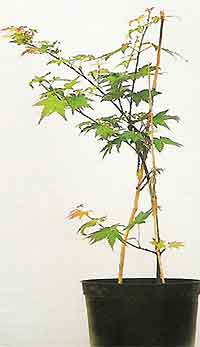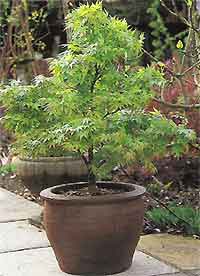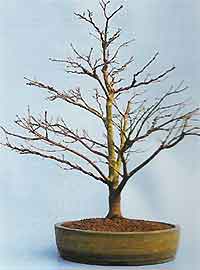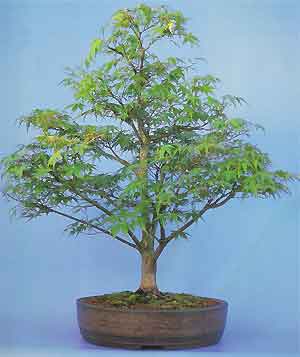Bonsai Trees
Case Histories
Japanese Mountain Maple - (acer palmatum)
Maple Bonsai Style: Formal Upright

I never actually intended this second maple to become a bonsai at all! I had so many successful maple air layerings that I decided to grow this particular tree as an attractive patio plant.
After two years establishing a good root system in a flower pot, I transplanted the maple into a deep, ceramic patio pot, using a layer of large polystyrene chunks to improve the drainage. This reduced the amount of soil that was needed and also the weight of the pot.
As the years progressed, constant trimming of any long growth resulted in a very bushy tree, with dense foliage. The shoots had slowly lengthened and the trunk had started to thicken considerably.

After the maple had been in the pot for five years, I decided to improve the appearance with some minor pruning and wiring. Some shoots had started to grow very upright and these were bent more downwards.
The very top of the tree also needed repositioning as it was growing to one side. It was wired more upright and thinned out. At this stage the maple did not have a definite front and was constantly turned to receive maximum light on all sides. It was very three dimensional, with evenly distributed branches, the direct result of regular turning which was necessary as it was growing near to a wall.
Maple Bonsai History: Training

By now the tree was most attractive and a real feature on the patio. The growth began to slow down as the tree was starting to get pot bound, however it was still very healthy and I continued pinching the shoots for a further year.
That spring I felt that it was high time to root prune the maple and with much resistance from the tree, I managed to lift it from the slightly incurved patio pot.
The root system was indeed pot bound and in need of some fresh soil. Without leaves, I noticed what a pleasing shape the maple had formed and I started to consider the possibilities of training it as a bonsai rather than a shapely bush!
I closely studied the tree from all angles, trying to decide which would be the most suitable front, but it presented several possibilities.

After much deliberation I selected the view that I considered would look the best. I root pruned hard, removing thick roots and leaving the more important fibrous roots. The surface roots were reasonable, but were crossing in several places. Two were removed to improve the root flair and the tree was planted in a large round bonsai pot.
I removed many major branches and generally thinned out any cluttered, clumsy growth to ensure an open and delicate structure when in leaf. The height was reduced by a quarter, pruning down to a suitable side branch that was growing upwards and this became the new leader. Many of the branches were now wired and positioned.
Looking at this tree I find it particularly satisfying that such an interesting and natural image has been created with such little effort. I particularly like the branch structure which appears so maple-like, being graceful and spreading. With time the surface roots will improve, the trunk will develop more mature bark and the branch ramification will build up, all enhancing this already sound maple.
 I never actually intended this second maple to become a bonsai at all! I had so many successful maple air layerings that I decided to grow this particular tree as an attractive patio plant.
I never actually intended this second maple to become a bonsai at all! I had so many successful maple air layerings that I decided to grow this particular tree as an attractive patio plant. After the maple had been in the pot for five years, I decided to improve the appearance with some minor pruning and wiring. Some shoots had started to grow very upright and these were bent more downwards.
After the maple had been in the pot for five years, I decided to improve the appearance with some minor pruning and wiring. Some shoots had started to grow very upright and these were bent more downwards. By now the tree was most attractive and a real feature on the patio. The growth began to slow down as the tree was starting to get pot bound, however it was still very healthy and I continued pinching the shoots for a further year.
By now the tree was most attractive and a real feature on the patio. The growth began to slow down as the tree was starting to get pot bound, however it was still very healthy and I continued pinching the shoots for a further year. After much deliberation I selected the view that I considered would look the best. I root pruned hard, removing thick roots and leaving the more important fibrous roots. The surface roots were reasonable, but were crossing in several places. Two were removed to improve the root flair and the tree was planted in a large round bonsai pot.
After much deliberation I selected the view that I considered would look the best. I root pruned hard, removing thick roots and leaving the more important fibrous roots. The surface roots were reasonable, but were crossing in several places. Two were removed to improve the root flair and the tree was planted in a large round bonsai pot.